Interstellar probe
.jpg)
An interstellar probe is a space probe that has left—or is expected to leave—the Solar System and enter interstellar space, which is typically defined as the region beyond the heliopause. It also refers to probes capable of reaching other star systems.
There are five interstellar probes: Voyager 1, Voyager 2, Pioneer 10, Pioneer 11 and New Horizons. As of 2015, Voyager 1 is the only probe to have actually reached interstellar space. The other four are on interstellar trajectories.
The termination shock is the point in the heliosphere where the solar wind slows down to subsonic speed. Even though the termination shock happens as close as 80–100 AU, the maximum extent of the region in which the Sun's gravitational field is dominant (the Hill sphere) is thought to be at around 230,000 astronomical units (3.6 light-years).[1] This point is close to the nearest known star system, Alpha Centauri, located 4.36 light years away. Although the probes will be under the influence of the Sun for a long time, their velocities far exceed Sun's escape velocity, so they will eventually leave forever.
Interstellar space is defined as that which lies beyond a magnetic region that extends about 122 AU from the sun, as detected by Voyager 1, and the equivalent region of influence surrounding other stars. The probe entered interstellar space in 2013.[2]
Interstellar Probe is also the name of a proposed NASA space probe intended to travel out 200 AU in 15 years, studied in 1999.[3]
In April 2016, scientists announced Breakthrough Starshot, a Breakthrough Initiatives program, to develop a proof-of-concept fleet of small centimeter-sized light sail spacecraft, named StarChip,[4] capable of making the journey to Alpha Centauri, the nearest extrasolar star system, at speeds of 20%[5][6] and 15%[7] of the speed of light, taking between 20 and 30 years to reach the star system, respectively, and about 4 years to notify Earth of a successful arrival.
Overview
Planetary scientist G. Laughlin noted that with current technology a probe sent to Alpha Centauri would take 40,000 years to arrive, but expressed hope for new technology to be developed to make the trip within a human lifetime.[8] On that timescale the stars move notably. As an example, in 40,000 years Ross 248 will be closer to Earth than Alpha Centauri.[9]

One technology that has been proposed to achieve higher speeds is an E-sail.[10] By harnessing solar wind, it might be possible achieve 20-30 AU per year without even using propellant.[10]
Existing interstellar probes
Functional spacecraft
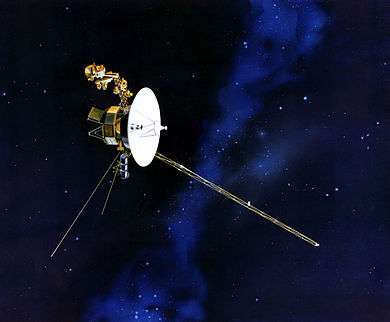
Voyager 1 (1977+)
Voyager 1 is a space probe launched by NASA on September 5, 1977. At a distance of about 134.57 AU (2.013×1010 km) as of 5 December 2016,[11][12] it is the farthest manmade object from Earth.[13]
It was later estimated that Voyager 1 crossed the termination shock on December 15, 2004 at a distance of 94 AU from the Sun.[14][15]
At the end of 2011 Voyager 1 entered and discovered a stagnation region where charged particles streaming from the Sun slow and turn inward, and the Solar System's magnetic field is doubled in strength as interstellar space appears to be applying pressure. Energetic particles originating in the Solar System declined by nearly half, while the detection of high-energy electrons from outside increases 100-fold. The inner edge of the stagnation region is located approximately 113 astronomical units from the Sun.[16][17]
In 2013 it was thought Voyager 1 crossed the heliopause and entered interstellar space on August 25, 2012 at distance of 121 AU from the Sun, making it the first known human-manufactered object to do so.[18][19]
As of 2013, the probe was moving with a relative velocity to the Sun of about 17.03 km/s (3.59 AU/year).[20]
If it does not hit anything, Voyager 1 could reach the Oort cloud in about 300 years[21][22]
Voyager 2 (1977+)

Voyager 2 passed the termination shock into the heliosheath on October 30, 2007. As of 5 December 2016 Voyager 2 is at a distance of 110.73 AU (1.656×1010 km) from Earth.[24] The probe was moving at a velocity of 3.25 AU/year (15.428 km/s) relative to the Sun on its way to interstellar space in 2013.[25]
Its moving at a velocity of 15.4 km/s (55,000 km/h) relative to the Sun as of December 2014 and is traveling through the heliosheath.[26] Upon reaching interstellar space, Voyager 2 is expected to provide the first direct measurements of the density and temperature of the interstellar plasma.[27]
New Horizons (2006+)
New Horizons was launched directly into a hyperbolic escape trajectory, getting a gravitational assist from Jupiter en route. By March 7, 2008, New Horizons was 9.37 AU from the Sun and traveling outward at 3.9 AU per year. It will, however, slow to an escape velocity of only 2.5 AU per year as it moves away from the Sun, so it will never catch up to either Voyager. As of early 2011, it was traveling at 3.356 AU/year (15.91 km/s) relative to the Sun.[28] On July 14, 2015, it completed a flyby of Pluto at a distance of about 33 AU from the Sun.[29][30] New Horizons is expected to encounter 2014 MU69 on January 1, 2019, at about 43.4 AU from the Sun.[31][32]
The Heliosphere's termination shock was crossed by Voyager 1 at 94 astronomical units (AU) and Voyager 2 at 84 AU according to the IBEX mission.[33]
If New Horizons can reach the distance of 100 AU, it will be traveling at about 13 km/s (29,000 mph), around 4 km/s (8,900 mph) slower than Voyager 1 at that distance.[34]
Inactive missions
Pioneer 10 (1972–2003)
The last successful reception of telemetry from Pioneer 10 was on April 27, 2002, when it was at a distance of 80.22 AU. Traveling at about 2.54 AU/year (12 km/s).[28]
Pioneer 11 (1973–1995)
Routine mission operations for Pioneer 11 were stopped September 30, 1995, when it was 6.5 billion km (approx 43.4 AU) from Earth. Traveling at about 2.4 AU/year (11.4 km/s).[28]
Probe debris
New Horizons' third stage, a STAR-48 booster, is on a similar escape trajectory out of the Solar System as New Horizons, but will pass millions of kilometers from Pluto.[28] It will cross Pluto's orbit in October 2015.[28]
The third stage rocket boosters for Pioneer 10, and for Voyager 1 and 2 are also on escape trajectories out of the Solar System.
Trans-Neptunian probes at precursor distances
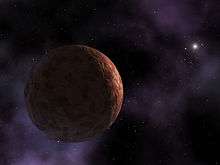
In the early 2000s many new, relatively large planetary bodies were found beyond Pluto, and with orbits extending hundreds of AU out past the heliosheath (90–1000 AU). The NASA probe New Horizons may explore this area now that it has performed its Pluto flyby in 2015 (Pluto's orbit ranges from about 29–49 AU). Some of these large objects past Pluto include 136199 Eris, 136108 Haumea, 136472 Makemake, and 90377 Sedna. Sedna comes as close as 76 AU, but travels out as far as 961 AU at aphelion, and minor planet (87269) 2000 OO67 goes out past 1060 AU at aphelion. Bodies like these affect how the Solar System is understood, and traverse an area previously only in the domain of interstellar missions or precursor probes. After the discoveries, the area is also in the domain of interplanetary probes; some of the discovered bodies may become targets for exploration missions,[35] an example of which is preliminary work on a probe to Haumea and its moons (at 35–51 AU).[36] Probe mass, power source, and propulsion systems are key technology areas for this type of mission.[35] In addition, a probe beyond 550 AU could use the Sun itself as a gravitational lens to observe targets outside the Solar System, such as planetary systems around other nearby stars,[37] although many challenges to this mission have been noted.[38]
Proposed interstellar probes
Missions that reach the interstellar medium or leave the heliosphere.
- Interstellar Heliopause Probe (IHP) (2006)
A technology reference study published in 2006 with the ESA proposed an interstellar probe focused on leaving the heliosphere. The goal would be 200 AU in 25 years, with traditional launch but acceleration by a solar sail. The roughly 200–300 kg probe would carry a suite of several instruments including a Plasma Analyzer, Plasma radio wave experiment, Magnetometer, Neutral and charged atom detector, Dust analyzer, and a UV-photometer. Electrical power would come from an RTG.[39]


NASA proposal to send a 35 kg science payload out to at least 200 AU. It would achieve a top speed of 7.8 AU per year using a combination of a heavy lift rocket, Jupiter gravitational assistance, and an ion engine powered by standard radioisotope thermal generators. The probe suggested a launch in 2014 (to take advantage of Jupiter gravitational assist), to reach 200 AU around 2044.[40]
- Realistic Interstellar Explorer & Interstellar Explorer (2000–2002)
Studies suggesting various technologies including Am-241-based RTG, optical communication (as opposed to radio), and low-power semi-autonomous electronics. Trajectory uses a Jupiter and Sun gravity assist to achieve 20 AU/year, allowing 1000 AU within 50 years, and a mission extension up to 20,000 AU and 1000 years. Needed technology included advanced propulsion and solar shield for perihelion burn around the Sun. Solar thermal (STP), nuclear fission thermal (NTP), and nuclear fission pulse, as well as various RTG isotopes were examined. The studies also included recommendations for a solar probe (see also Solar Probe Plus), nuclear thermal technology, solar sail probe, 20 AU/year probe, and a long term vision of a 200 AU/year probe to the star Epsilon Eridani.[41]
The "next step" interstellar probe in this study suggested a 5 megawatt fission reactor utilizing 16 metric tonnes of H2 propellant.[42] Targeting a launch in the mid-21st century, it would accelerate to 200 AU/year over 4200 AU and reach the star Epsilon Eridani after 3400 years of travel in the year 5500 AD.[42] However, this was a second-generation vision for a probe and the study acknowledged that even 20 AU/year might not be possible with then current (2002) technology.[42] For comparison, the fastest probe at the time of the study was Voyager 1 at about 3.6 AU/year (17 km/s), relative to the Sun.[28]
Interstellar Probe was a proposed solar sail propulsion spacecraft planned by NASA Jet Propulsion Laboratory. It was planned to reach as far as 200 AU within 10 years at a speed of 14 AU/year (about 70 km/s, and function up to 400+ AU.[3] A critical technology for the mission is a large 1 g/m2 solar sail.
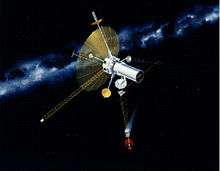
- TAU mission (1987)
TAU mission (Thousand Astronomical Units) was a proposed nuclear electric rocket craft that used a 1 MW fission reactor and an ion drive with a burn time of about 10 years to reach a speed of 106 km/s (about 20 AU/year) to achieve a distance of 1000 AU in 50 years.[43] The primary goal of the mission was to improve parallax measurements of the distances to stars inside and outside our galaxy, with secondary goals being the study of the heliopause, measurements of conditions in the interstellar medium, and (via communications with Earth) tests of general relativity.[44]
Interstellar concepts
- Project Orion (1958–1965)
Project Orion was a proposed nuclear pulse propulsion craft that would have used fission or fusion bombs to apply motive force. The design was studied during the 1950s and 1960s in the United States of America, with one variant of the craft capable of interstellar travel.
- Bracewell probe (1960)
Interstellar communication via a probe, as opposed to sending an electromagnetic signal.
- Sanger Photon Rocket (1950s-1964)
Eugene Sanger proposed a spacecraft powered by antimatter in the 1950s.[45] Thrust was intended to come from reflected gamma-rays produced by electron-positron annihilation.[45]
- Enzmann Starship (1964/1973)
Proposed by 1964 and examined in an October 1973 issue of Analog, the Enzmann Starship proposed using a 12,000 ton ball of frozen deuterium to power thermonuclear powered pulse propulsion.[46] About twice as long as the Empire State Building and assembled in-orbit, the spacecraft was part of a larger project preceded by large interstellar probes and telescopic observation of target star systems.[46][47][48]
- Project Daedalus (1973–1978)
Project Daedalus was a proposed nuclear pulse propulsion craft that used inertial confinement fusion of small pellets within a magnetic field nozzle to provide motive force. The design was studied during the 1970s by the British Interplanetary Society, and was meant to flyby Barnard's Star in under a century from launch. Plans included mining Helium-3 from Jupiter and a pre-launch mass of over 50 thousand metric tonnes from orbit.
- Project Longshot (1987–1988)
Project Longshot was a proposed nuclear pulse propulsion craft that used inertial confinement fusion of small pellets within a magnetic field nozzle to provide motive force, in a manner similar to that of Project Daedalus. The design was studied during the 1990s by NASA and the US Naval Academy. The craft was designed to reach and study Alpha Centauri.
- Starwisp (1985)
Starwisp is a hypothetical unmanned interstellar probe design proposed by Robert L. Forward. It is propelled by a microwave sail, similar to a solar sail in concept, but powered by microwaves from an artificial source.
- Medusa (1990s)
Medusa was a novel spacecraft design, proposed by Johndale C. Solem, using a large lightweight sail (spinnaker) driven by pressure pulses from a series of nuclear explosions. The design, published by the British Interplanetary Society, was studied during the 1990s as a means of interplanetary travel.[49][50][51][52][53]
- Starseed launcher (1996)
Starseed launcher was concept for launching microgram interstellar probes at up to 1/3 light speed.[54]
- AIMStar (1990s-2000s)
AIMStar was a proposed antimatter catalyzed nuclear pulse propulsion craft that would use clouds of antiprotons to initiate fission and fusion within fuel pellets.[55] A magnetic nozzle derived motive force from the resulting explosions. The design was studied during the 1990s by Penn State University. The craft was designed to reach a distance of 10,000 AU from the Sun in 50 years.
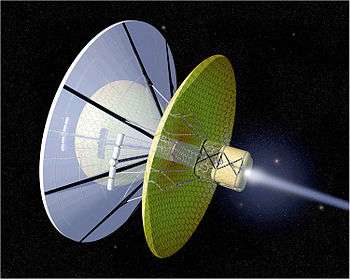
- Project Icarus (2009+)
Project Icarus is a theoretical study for an interstellar probe and is being run under the guidance of the Tau Zero Foundation (TZF) and the British Interplanetary Society (BIS), and was motivated by Project Daedalus, a similar study that was conducted between 1973 and 1978 by the BIS.[56] The project is planned to take five years and began on September 30, 2009.[57]
- Project Dragonfly (2014+)
The Initiative for Interstellar Studies (i4is) has initiated a project working on small interstellar spacecraft, propelled by a laser sail in 2014 under the name of Project Dragonfly.[58][59] Four student teams worked on concepts for such a mission in 2014 and 2015 in the context of a design competition.[60][61]
Geoffrey A. Landis proposed for interstellar travel future-technology project interstellar probe with supplying the energy from an external source (laser of base station) and ion thruster.[62][63]
Other interplanetary probes of interest
Other probes of interest to suggested interstellar missions.

- NASA Dawn (launched 2007), using solar-powered xenon-ion thrusters, achieving a velocity change of over 10 km/s [64]
- Solar Probe Plus, planned probe approaches Sun within about 8-9 solar radii. (Interstellar probes using a solar gravity assist need to survive Sun perihelion)
- Deep Space 1 (1999–2001), demonstrated ion engines and Ka-band radio communications.
- Ulysses (1990–2009), Out-Of-The-Ecliptic mission meant large velocity change of 15.4 km/s (IUS & Pam-S booster)[42] and Jupiter gravity assist. Used RTG for power.
- IKAROS (2010), NanoSail-D2 (2010), LightSail-1 (2016), solar sail tests
Technologies
Some technologies that have been discussed in relation to making an interstellar probe.
Gravity assist
A traditional gravity assist can be compared to throwing a tennis ball at a train (it rebounds not just with incoming velocity, but is accelerated by the train), it uses the gravity of a planet and its relative motion around the Sun compared to the spacecraft.[65] For example, Voyager 2 increased its velocity by performing gravity assists at Jupiter, Saturn, and Uranus.[66]
Oberth effect
Herman Oberth conceived of type gravity assist in 1929.[67]
RTGs
An example of RTG used on a probe leaving the Solar system is the Voyagers. Typically these have used Plutonium but an RTG using 241Am was proposed for an interstellar type mission in 2002.[42] This could support mission extensions up to 1000 years on the interstellar probe, because the power output would be more stable in the long-term than plutonium.[42] Other isotopes for RTG were also examined in the study, looking at traits such as watt/gram, half-life, and decay products.[42] An interstellar probe proposal from 1999 suggested using three advanced radioisotope power source.[68] An RTG using 241Am was also studied as RTG fuel by the ESA[69]
Ion engines
Solar sails
Probes messages
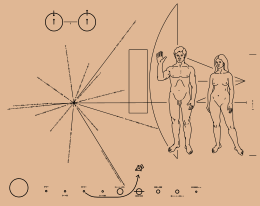
The Pioneer plaques are a pair of gold-anodized aluminium plaques placed on board the 1972 Pioneer 10 and 1973 Pioneer 11 spacecraft, featuring a pictorial message in case they are rediscovered |
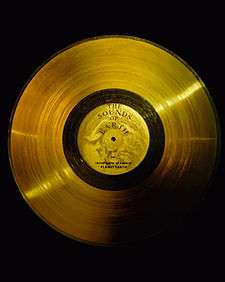 Each Voyager Golden Record, as included aboard the Voyager 1 and Voyager 2 spacecraft, features audio recordings and encoded pictures |
See also
- Selected programs
- NERVA (ending 1972), tested nuclear fission thermal rocket engine
- NASA Project Prometheus (ending 2006)
- Jupiter Icy Moons Orbiter (ending 2005), nuclear fission electric ion engine
- Breakthrough Propulsion Physics Program (1996–2002), evaluated advanced propulsion technology
- Interstellar Boundary Explorer (IBEX) (2008), space observatory that measured energetic neutral atoms from interstellar boundary.
- TAU (spacecraft), proposed spacecraft capable of reaching 1000 AU in 50 years.
- Outer Space
- List of nearest stars (nearest to Earth)
- Heliosphere & Interstellar Medium
- Kuiper belt (30-50 AU) & Oort cloud (2,000 to 200,000 AU)
- Local Interstellar Cloud (aka Local Fluff & 30 light years across) & Local Bubble (300 light years across) (1 light-year ≈ 63,241 AU)
- Examples of distance in AU
- Space travel
References
- ↑ Chebotarev, G.A. (1964), "Gravitational Spheres of the Major Planets, Moon and Sun", Soviet Astronomy, 7 (5): 618–622, Bibcode:1964SvA.....7..618C, retrieved 2010-03-24
- ↑ NASA Voyager 1 Encounters New Region in Deep Space
- 1 2 "Interstellar Probe". Interstellar.jpl.nasa.gov. 2002-02-05. Retrieved 2010-10-22.
- ↑ Gilster, Paul (12 April 2016). "Breakthrough Starshot: Mission to Alpha Centauri". Centauri Dreams. Retrieved 14 April 2016.
- ↑ Overbye, Dennis (12 April 2016). "A Visionary Project Aims for Alpha Centauri, a Star 4.37 Light-Years Away". New York Times. Retrieved 12 April 2016.
- ↑ Stone, Maddie (12 April 2016). "Stephen Hawking and a Russian Billionaire Want to Build an Interstellar Starship". Gizmodo. Retrieved 12 April 2016.
- ↑ Staff (12 April 2016). "Breakthrough Starshot". Breakthrough Initiatives. Retrieved 12 April 2016.
- ↑ Lemonick, Michael (17 October 2012). "An Earthlike World in the Cosmic Neighborhood". Time. Retrieved 21 October 2012.
- ↑ Matthews, R. A. J. (Spring 1994). "The Close Approach of Stars in the Solar Neighborhood". Quarterly Journal of the Royal Astronomical Society. 35 (1): 1. Bibcode:1994QJRAS..35....1M.
- 1 2 "Electric sail solar-wind space exploration", Space.com
- ↑ Voyager 1, Where are the Voyagers – NASA Voyager 1
- ↑ Peat, Chris (September 9, 2012). "Spacecraft escaping the Solar System". Heavens-Above. Retrieved September 9, 2012.
- ↑ http://www.theguardian.com/science/across-the-universe/2013/sep/13/voyager-1-solar-system-great-explorers
- ↑ "Voyager crosses termination shock". Retrieved August 29, 2013.
- ↑ "Voyager Timeline". NASA/JPL. February 2013. Retrieved December 2, 2013.
- ↑ "Spacecraft enters 'cosmic purgatory'". CNN. December 6, 2011. Retrieved December 7, 2011.
- ↑ "Voyager 1 hits new region at Solar System edge". December 5, 2011. Retrieved December 7, 2011.
- ↑ Morin, Monte (September 12, 2013). "NASA confirms Voyager 1 has left the Solar System". Los Angeles Times.
- ↑ "Report: NASA Voyager Status Update on Voyager 1 Location". NASA. Retrieved March 20, 2013.
- ↑ "Voyager Mission Operations Status Report # 2013-09-06, Week Ending September 6, 2013". JPL. Retrieved September 15, 2013.
- ↑ "Catalog Page for PIA17046". Photo Journal. NASA. Retrieved April 27, 2014.
- ↑ "It's Official: Voyager 1 Is Now In Interstellar Space". UniverseToday. Retrieved April 27, 2014.
- ↑ Basics of space flight: Interplanetary Trajectories
- ↑ Jpl.Nasa.Gov. "Where are the Voyagers - NASA Voyager". Voyager.jpl.nasa.gov. Retrieved 2013-09-14.
- ↑ "Voyager Mission: Weekly Reports of 15 July 2013". Retrieved 15 July 2013.
- ↑ "Voyager Mission: Weekly Reports of 26 December 2014".
- ↑ "At last, Voyager 1 slips into interstellar space – Atom & Cosmos". Science News. 2013-09-12. Retrieved 2013-09-17.
- 1 2 3 4 5 6 Spacecraft escaping the Solar System (Chris Peat, Heavens-Above GmbH)
- ↑
- ↑
- ↑ Talbert, Tricia (August 28, 2015). "NASA's New Horizons Team Selects Potential Kuiper Belt Flyby Target". NASA. Retrieved September 4, 2015.
- ↑ Cofield, Calla (August 28, 2015). "Beyond Pluto: 2nd Target Chosen for New Horizons Probe". Space.com. Retrieved August 30, 2015.
- ↑ What is the termination shock?
- ↑ "New Horizons Salutes Voyager". Johns Hopkins APL. August 17, 2006. Archived from the original on March 9, 2011. Retrieved November 3, 2009.
- 1 2 Poncyb, Joel; Fontdecaba Baiga, Jordi; Feresinb, Fred; Martinota, Vincent (2011). "A preliminary assessment of an orbiter in the Haumean system: How quickly can a planetary orbiter reach such a distant target?". Acta Astronautica. 68 (5-6): 622–628. doi:10.1016/j.actaastro.2010.04.011.
- ↑ Paul Gilster: Fast Orbiter to Haumea. Centauri Dreams—The News of the Tau Zero Foundation. July 14, 2009, retrieved January 15, 2011
- ↑ Paul Gilster: The FOCAL Mission: To the Sun’s Gravity Lens, August 18, 2006; and Starshot and the Gravitational Lens, April 25, 2016. Centauri Dreams—The News of the Tau Zero Foundation (access date 28 April 2016).
- ↑ A Space Mission to the Gravitational Focus of the Sun,MIT Technology Review, April 2016 (access date 28 April 2016)
- ↑ ESA - The Interstellar Heliopause Probe
- ↑ "Innovative Interstellar Probe". Interstellarexplorer.jhuapl.edu. Retrieved 2010-10-22.
- ↑ Ralph L. McNutt, et all - Interstellar Explorer (2002) - Johns Hopkins University (.pdf)
- 1 2 3 4 5 6 7 Ralph L. McNutt, et all – Interstellar Explorer (2002) – Johns Hopkins University (.pdf)
- ↑ "Preliminary scientific rationale for a voyage to a thousand astronomical units". Jet Propulsion Laboratory.
- ↑ "Tau - A Mission to a Thousand Astronomical Units" (PDF). Jet Propulsion Laboratory.
- 1 2 Joel Davis - With anti-matter to the stars - New Scientist (Jun 24, 1989) (Google Books Link)
- 1 2 Enzmann Starship
- ↑ Centari Dreams: A Note on the Enzmann Starship by Paul Gilster on April 1, 2007
- ↑ Ian Ridpath - Messages from the stars: communication and contact with extraterrestrial life (1978, Harper & Row, 241 pages) = Google Books 2010, Quote: "As long ago as 1964, Robert D. Enzmann of the Raytheon Corporation proposed an interstellar ark driven by eight nuclear pulse rockets. The living quarters of the starship, habitable by 200 people but with room for growth, ..."
- ↑ Solem, J. C. (January 1993). "Medusa: Nuclear explosive propulsion for interplanetary travel". Journal of the British Interplanetary Society. 46 (1): 21–26. Bibcode:1993JBIS...46R..21S. ISSN 0007-084X.
- ↑ Solem, J. C. (June 1994). "Nuclear explosive propulsion for interplanetary travel: Extension of the MEDUSA concept for higher specific impulse". Journal of the British Interplanetary Society. 47 (6): 229–238. Bibcode:1994JBIS...47..229S. ISSN 0007-084X.
- ↑ Gilster, Paul (2004). Centauri Dreams: Imagining and Planning Interstellar Exploration. Copernicus Books, Atlanta Book Company. ISBN 038700436X.
- ↑ Matloff, Gregory L. (2005). Deep Space Probes: To the Outer Solar System and Beyond. Springer Praxis Books. ISBN 3540247726.
- ↑ Long, Kelvin F. (2011). Deep Space Propulsion: A Roadmap to Interstellar Flight. Astronomers' Universe, Springer. ISBN 1461406064.
- ↑ "Starseed/Launcher" - by Forrest Bishop (accessed October 28, 2010)
- ↑ Lewis, Raymond A; Meyer, Kirby; Smith, Gerald A; Howe, Steven D. "AIMStar: Antimatter Initiated Microfusion For Pre-cursor Interstellar Missions" (PDF). Archived from the original (PDF) on June 16, 2014. Retrieved June 27, 2015.
- ↑ Leonard David, "Futuristic interstellar space probe idea revisited", MSNBC, May 9, 2010.
- ↑ Stephen Ashworth FBIS, "Project Icarus - Son of Daedalus", Spaceflight, 454-455 (December 2009).
- ↑ “Project Dragonfly”, i4is.org/news/dragonfly
- ↑ http://www.centauri-dreams.org/?p=31478
- ↑ http://kickstarter.com/projects/1465787600/project-dragonfly-sail-to-the-stars
- ↑ http://www.centauri-dreams.org/?p=33025
- ↑ Laser-Powered Interstellar Probe G Landis - APS Bulletin, 1991
- ↑ Geoffrey A. Landis. Laser-powered Interstellar Probe on the Geoffrey A. Landis: Science. papers available on the web
- ↑ "Dawn: Mission description". UCLA Space Physics Center. 2006-10-17. Retrieved 2007-09-28.
- ↑ A Gravity Assist Primer
- ↑ Basics of Spaceflight Section 1 Chapter 4. Interplanetary Trajectories
- ↑ AIAA2001-3377 Solar Thermal Propulsion for an Interstellar probe
- ↑ "Interstellar Probe". NASA/JPL. 5 February 2002. Retrieved 22 October 2010.
- ↑ Dr Major S. Chahal, , UK Space Agency, 9 Feb 2012, retrieved 13 Nov 2014.
Further reading
- NASA's Interstellar Probe Mission (1999) (.pdf)
- Leonard David - Reaching for interstellar flight (2003) - MSNBC (MSNBC Webpage)
- Ralph L. McNutt, et al. - A Realistic Interstellar Explorer (2000) - Johns Hopkins University (.pdf)
- McNutt, et al. - Radioisotope Electric Propulsion (2006) - NASA Glenn Research Center (includes Centaur orbiter mission)
- Scott W. Benson - Solar Power for Outer Planets Study (2007) - NASA Glenn Research Center (with SEP booster)
External links
- Spacecraft escaping the Solar System
- List of interstellar spaceships and probes
- NASA - Interstellar Probe (2002 era Study)
- Voyager mission website (NASA)